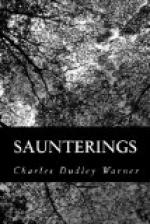In the streets one still sees peasant women in native costume. There was a group to-day that I saw by the river, evidently just crossed over from North Holland. They wore short dresses, with the upper skirt looped up, and had broad hips and big waists. On the head was a cap with a fall of lace behind; across the back of the head a broad band of silver (or tin) three inches broad, which terminated in front and just above the ears in bright pieces of metal about two inches square, like a horse’s blinders, Only flaring more from the head; across the forehead and just above the eyes a gilt band, embossed; on the temples two plaits of hair in circular coils; and on top of all a straw hat, like an old-fashioned bonnet stuck on hindside before. Spiral coils of brass wire, coming to a point in front, are also worn on each side of the head by many. Whether they are for ornament or defense, I could not determine.
Water is brought into the city now from Haarlem, and introduced into the best houses; but it is still sold in the streets by old men and women, who sit at the faucets. I saw one dried-up old grandmother, who sat in her little caboose, fighting away the crowd of dirty children who tried to steal a drink when her back was turned, keeping count of the pails of water carried away with a piece of chalk on the iron pipe, and trying to darn her stocking at the same time. Odd things strike you at every turn. There is a sledge drawn by one poor horse, and on the front of it is a cask of water pierced with holes, so that the water squirts out and wets the stones, making it easier sliding for the runners. It is an ingenious people!
After all, we drove out five miles to Broek, the clean village; across the Y, up the canal, over flatness flattened. Broek is a humbug, as almost all show places are. A wooden little village on a stagnant canal, into which carriages do not drive, and where the front doors of the houses are never open; a dead, uninteresting place, neat but not specially pretty, where you are shown into one house got up for the purpose, which looks inside like a crockery shop, and has a stiff little garden with box trained in shapes of animals and furniture. A roomy-breeched young Dutchman, whose trousers went up to his neck, and his hat to a peak, walked before us in slow and cow-like fashion, and showed us the place; especially some horrid pleasure-grounds, with an image of an old man reading in a summer-house, and an old couple in a cottage who sat at a table and worked, or ate, I forget which, by clock-work; while a dog barked by the same means. In a pond was a wooden swan sitting on a stick, the water having receded, and left it high and dry. Yet the trip is worth while for the view of the country and the people on the way: men and women towing boats on the canals; the red-tiled houses painted green, and in the distance the villages, with their spires and pleasing mixture of brown, green, and red tints, are very picturesque. The best thing that I saw, however, was a traditional Dutchman walking on the high bank of a canal, with soft hat, short pipe, and breeches that came to the armpits above, and a little below the knees, and were broad enough about the seat and thighs to carry his no doubt numerous family. He made a fine figure against the sky.




